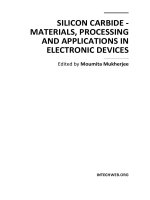Silicon Carbide Materials Processing and Applications in Electronic Devices Part 5 pot
Bạn đang xem bản rút gọn của tài liệu. Xem và tải ngay bản đầy đủ của tài liệu tại đây (4.47 MB, 35 trang )
Silicon Carbide – Materials, Processing and Applications in Electronic Devices
130
of diamond particles. The reason behind this is that the thermal conductivity of the
nominally pure aluminium matrix is influenced by take-up of some silicon from the silicon
carbide. It was shown in (Molina et al., 2008b) that the intrinsic value of the thermal
conductivity of pure aluminium in composites fabricated via gas-pressure infiltration might
be as low as 185 W/mK, because of the presence of silicon in solid solution in combination
with precipitated silicon phase in the matrix. Reactivity of liquid aluminium and SiC in the
“as-received” condition seems unavoidable in gas-pressure infiltration, since the time
elapsed during pressurization of the chamber and posterior solidification is of the order of
some minutes, depending on the special characteristics of the equipment at hand.
Decreasing as much as possible the infiltration temperature seems then to be a successful
way to avoid metal-ceramic reactivity in SiC-based systems.
4.3.2 Metal/SiC-graphite flakes composites
A very recent family of composite materials has been developed and patented at the
University of Alicante (Narciso et al., 2007; Prieto et al., 2008). The invention is concerned
with a composite material with high thermal performance and low cost which has a layered
structure achieved by proper combination of different components. The components of the
material are three: 1) a phase mainly formed by graphite flakes (phase A); 2) a second phase
(phase B) involving particles or fibers of a material which can act as a phase separator of
phase A (phase B is a ceramic material preferably selected from the group of SiC, BN, AlN,
TiB
2
, diamond and carbon fibers); and finally, 3) a third phase (phase C) formed by a
metallic alloy. The three present phases must have good thermal properties, although their
main function is different for each one: phase A (graphite flakes) is the principal responsible
of the properties of the final material, phase B acts as a separator of the layers of phase A
and phase C has to consolidate the preform.
The resultant layered structure of these composites is mainly due to the fact that graphite
flakes naturally tend to lie on top of each other, especially when a given pressure is applied.
It is in fact due to this tendency to get densely packed that, when only flakes are present,
they almost leave no space between them and infiltration becomes an almost unfeasible
task. The presence of another ceramic (phase B), like SiC particles, allows molten metal
infiltration by keeping the graphite flakes separated. The feasibility of the fabrication
procedure of these composites was demonstrated in (Prieto et al., 2008).
A representative illustration of the microstructures of these composites is given in Fig. 10.
(a) (b)
Fig. 10. Micrographs of: (a) graphite flakes and (b) composite material obtained by infiltration
with Al-12%Si of preforms obtained by mixing graphite flakes (60%) with SiC particles (40%)
SiC as Base of Composite Materials for Thermal Management
131
Table 4 shows the most significant results of the thermal properties for some of these
materials. These composites recently developed present exceptionally high values of
thermal conductivity. The thermal properties are clearly anisotropic, given the fact
mentioned before that graphite flakes are oriented in a plane, for which they exhibit the
maximum thermal conductivity and the lowest CTE (xy-plane in Table 4).
Reinforcement Metal V
r
CT
(
W/mK
)
CTE
(pp
m/K
)
60% graphite flakes + 40% SiC Al-12%Si 0.88
x
y
: 368
z: 65
z: 11
x
y
: 7.0
63% graphite flakes + 37% SiC Ag-3%Si 0.88
x
y
: 360
z: 64
z: 11
x
y
: 8.0
Table 4. Thermal properties of metal/SiC-graphite flakes composites. xy refers to the
graphene planes, while the direction perpendicular to it is denoted by z
Although the properties presented in Table 4 are very good, the authors of the patent (Narciso
et al., 2007) have already encountered even more promising values when special conditions of
infiltration are used. The thermal properties of these composites are currently being evaluated
by means of different modelling schemes, conveniently adapted to account for both the
anisotropic microstructure of the materials at the mesoscale and the anisotropy in the intrinsic
thermal properties of the graphite flakes. Modelling on this system arouses special interest
since it is a very cheap and machinable material which has attracted the interest for many
applications and represents a clear alternative candidate for heat sinking.
5. Selection of processing conditions for fabrication of SiC-based composite
materials for thermal management
The thermal properties of composite materials are mainly determined by the intrinsic properties
of their constituents and the characteristics of the matrix-reinforcement interface. Aside an
appropriate selection of the constituents it is essential to control the processing conditions
during fabrication of the material in order to generate a proper interface able to effectively
transfer the heat across the different constituent phases. During fabrication of a composite
material by infiltration or squeeze casting some of these processing conditions concern:
i.
Ceramic particulate (average diameter, size distribution, shape, packed volume
fraction)
ii.
Liquid metal (surface tension, viscosity)
iii.
Liquid-solid interface (wettability, reactivity)
iv.
Experimental variables (maximum applied pressure, pressurization rate, temperature,
infiltration atmosphere)
Next sections will focus on different aspects in regard to the most important parameters that
mainly determine the thermal properties of SiC-based composite materials: wettability-
reactivity at the liquid-solid interface, maximum applied pressure and pressurization rate.
5.1 Threshold pressure for infiltration
An outstanding technologically relevant parameter in composite materials processing is the
threshold (
P
0
), or minimum, pressure to achieve the entrance of the molten metal into the
porous preform. Being essential for materials validation, its measurement is, however, not
simple. One of the methods to get the threshold pressure of a given system is to infiltrate a
Silicon Carbide – Materials, Processing and Applications in Electronic Devices
132
preform at various applied pressures and measure, for a fixed time, the infiltrated height for
each pressure (Garcia-Cordovilla et al., 1999, Molina et al., 2004; Molina et al, 2008; Piñero et
al, 2008). Data are then analysed by means of Darcy’s law:
()
()
2
2
1
o
r
kt
hPP
V
μ
⋅
=−
⋅−
(11)
where
k is the permeability of the porous solid, t is the infiltration time and
μ
the viscosity of
the liquid metal.
P
0
can be easily derived from plots of h
2
vs P.
Threshold pressure and contact angle are intimately correlated by means of the so-called
capillary law:
()
0
6
1
cos cos
r
lv lv
r
V
P
VD
λ
γ
θ
γ
θ
=⋅⋅ =⋅Σ⋅
−⋅
(12)
being
θ
the contact angle and
γ
lv
the surface tension of the molten metal at the infiltration
temperature. The value of
P
0
is clearly dependent on the wetting characteristics of the
system and, hence, may be strongly affected by the reactive phenomena occurring at the
interface between metal and substrate while the infiltration front moves over the substrate
surface. The study of this parameter becomes especially interesting for those systems where
infiltration front movement and reaction cannot be decoupled in time. A remarkable fact
that has to be taken in consideration is that if infiltration occurs too rapidly, reaction could
be prevented and the system may behave as non-reactive. A conclusive study regarding
these points was presented in (Molina et al., 2007b; Tian et al., 2005), which discusses results
for infiltration of pure Al and Al-12wt%Si into compacts of as-received and thermally
oxidized SiC particles. The main results of this study are summarized in Fig. 11a.
0
200
400
600
800
1000
1200
1400
500 600 700 800 900
pressure (kPa)
h
2
(mm
2
)
500
550
600
650
700
750
800
850
900
700 900 1100 1300 1500
γ
lv
Σ (kPa)
P
0
(kPa)
(a) (b)
Fig. 11. (a) Plots of the square of the infiltrated height
h
2
as a function of applied pressure P for
gas pressure infiltration at 700ºC of Al and Al-12%Si in preforms of SiC particles in the as-
received and oxidized conditions: Al/SiC500 (
), Al-12%Si/SiC500 (), Al/SiC500ox (), Al-
12%Si/SiC500ox (
), Al/SiC400 (), Al-12%Si/SiC400 (), Al/SiC400ox () and Al-
12%Si/SiCox (
). The straight lines are linear fittings of experimental data; (b) Threshold
pressure
P
0
versus γ
lv
for the different systems in (a). The line corresponds to a fitting with
equation
P
0
= 0.603
γ
lv
+ 32.9 kPa
SiC as Base of Composite Materials for Thermal Management
133
The most important conclusion is that the contact angle derived from a fitting of the
experimental data (Fig. 11b) by means of Eq. (12) is the same for all cases studied. The
infiltration behaviour of the different systems, governed by a unique contact angle, indicates
that the metal/particle interface is in both cases the same. Instead of being a metal/SiC
contact, there exists an interlayer of silica between both. The very thin silica layer that covers
naturally the SiC particles seems to be thick enough to partly remain after reaction with the
metal during infiltration at these low temperatures and relatively rapid infiltration kinetics.
Another system with remarkable interest is Ag/SiC (Garcia-Cordovilla et al., 1999; Molina et
al., 2003b). Silver is a metal with high capacity for dissolution of oxygen in the molten state.
This oxygen can rapidly oxidize the SiC particles. This was observed to affect directly the
threshold pressure of the system by increasing its value. The apparent contact angle derived
from the data was 168º. The authors suggested that the gas evolved during the oxidation of
SiC reduced the contact area and, in consequence, wetting.
5.2 Drainage curves for gas-pressure infiltration
Determination of threshold pressures is often not sufficient to fully characterize wetting in
infiltration processing. Intrinsic capillary parameters, characteristic of dynamic wetting of a
discrete reinforcement, are not, per se, equal to those derived in near-static conditions (i.e.
sessile drop measurements). Furthermore, preforms are invaded over a range of pressures
that is governed by the complex internal geometry of open pores within the preform
(Rodriguez-Guerrero et al., 2008). A more thorough characterization of wetting is obtained
by the so-called drainage curves. These are plots of the metallic saturation (fraction of non-
wetting fluid in the porous medium) versus the pressure difference between the fluid and
the atmosphere in the pores. These drainage curves contain all information related to
wetting of the porous preform by the non-wetting liquid. With the assumption that
irreversibility effects (e.g. Haines jumps) and other inertial losses can be neglected, the work
of immersion (
W
i
) can be calculated as the work necessary to fully infiltrate the preform (W)
divided by the total preform/infiltrant interface created per unit volume of reinforcement:
()
1
r
i
Vr Vr
VPdS
W
W
AV AV
−⋅
==
⋅⋅
(13)
where
P, S and V
r
are saturation, applied pressure and volume fraction of reinforcement,
respectively;
A
v
is the particle specific surface area per unit volume of preform. The contact
angle can be easily derived by making use of the following relationship:
cos
ilv
W
γ
θ
=⋅ (14)
Recently, a new technique was proposed for the direct measurement of capillary forces during
the infiltration process of high-temperature melting non-wetting liquids into ceramic
preforms. In essence, the equipment is a high-temperature analogue of mercury porosimetry.
The device can track dynamically the volume of metal that is displaced during pressurization
and hence allows obtaining in a single experiment the entire drainage curve characterizing
capillarity in high-temperature infiltration of particles by molten metal (Bahraini et al., 2005;
Bahraini et al., 2008; Molina et al., 2007a; Molina et al., 2008d). The technique was validated in
an study of wetting of silicon carbide by pure aluminium and by aluminium-silicon eutectic
alloy using drainage curves obtained during gas pressure infiltration at 750ºC.
Silicon Carbide – Materials, Processing and Applications in Electronic Devices
134
With relatively fast pressurization rates the drainage curves for a metal/SiC system that can
be obtained are shown in Fig. 12 for SiC320 particles of about 37
μm of average diameter.
The shape of the curves is determined by the shape of particles in the preform. Any change of
(i) the work of immersion, (ii) the particle volume fraction and/or (iii) the particle size (which
is accounted for by
A
v
parameter) will cause a predictable shift over the pressure axis. The
values of contact angle derived from the drainage curves for different sizes of SiC particles
with Al and Al-12%Si are in the range 110-113º. These values are fully consistent with
measurements with the sessile drop method for the wetting of oxide-covered SiC by molten
aluminium free of a surface layer of oxide. In these infiltration experiments the triple line is
forced to move at a motion rate which is well above the “natural” rate dictated by reaction
kinetics in the sessile drop method. Hence, infiltration and reaction processes are decoupled in
time and the SiC surface is covered before reaction can take place at the interface.
Nevertheless, when pressurization rate is decreased, the interfacial reaction can take place
concomitantly with the motion of the triple line and both phenomena may interact to
provoque different behaviours in drainage curves. Fig. 13 shows drainage curves for the
infiltration of SiC particles with molten Al and Al-Si eutectic at a reduced pressurization rate
of 0.05MPa/s together with the curves obtained for the same systems at 0.13 MPa/s.
0
0.2
0.4
0.6
0.8
1
1.2
00.511.52
pressure (MPa)
saturation
SiC320/Hg
SiC320/Al
SiC320/Al12Si
Fig. 12. Drainage curves of SiC320 infiltrated with Hg, Al and Al-12%Si at 750ºC
0
0.2
0.4
0.6
0.8
1
1.2
024681012
pressure (MPa)
saturation
SiC1000/Al (0.13MPa/s)
SiC1000/Al (0.05MPa/s)
0
0.2
0.4
0.6
0.8
1
1.2
024681012
pressure (MPa)
saturation
SiC1000/Al12Si (0.13 MPa/s)
SiC1000/Al12Si (0.05 MPa/s)
Fig. 13. Drainage curves at 750ºC of (a) SiC1000/Al and (b) SiC1000/Al-12%Si, measured at
the two pressurization rates of 0.13 and 0.05 MPa/s
SiC as Base of Composite Materials for Thermal Management
135
The curves of Fig. 13 show that interfacial reactions, which have proven in sessile-drop
experiments to aid wetting, under forced pressure-driven infiltration can hinder infiltration
of SiC preforms by aluminium-based melts. These effects can be due to the fact that
chemical interactions can cause morphological changes at the solid/liquid interface. As a
corollary, rapid pressure infiltration is preferable in processing metal matrix composites
featuring interfacial reactivity.
5.3 Gas pressure infiltration vs squeeze casting
It is interesting to compare the resulting materials processed by two different liquid-state
routes, namely gas-pressure infiltration and squeeze casting, which make use of different
pressures and pressurization rates (this having a direct implication on the contact time
between molten metal and particles before metal is solidified).
In (Weber et al., 2010) it is presented a complete study of comparison of the different
properties encountered for Al/SiC composites processed by these two fabrication
techniques. In this work, bimodal powder mixtures of green quality SiC powders with
average sizes of 170
μm and 17 μm, respectively, were used. A set of samples was processed
by squeeze casting while other two sets were prepared by gas pressure-assisted infiltration
at two largely different infiltration kinetics. Fig. 14a resumes the thermal conductivities for
both series of composites together with modelling predictions using the DEM scheme.
150
160
170
180
190
200
210
220
230
240
250
0 0.2 0.4 0.6 0.8
fraction of coarse particles
thermal conductivity (W/mK)
SC
GPI - fast
GPI - slow
0
2
4
6
8
10
12
0.50.550.60.650.70.75
particle volume fraction
CTE (ppm/K)
GPI - fast at 25ºC
GPI - fast at 125ºC
SC at 25ºC
SC at 125ºC
(a) (b)
Fig. 14. (a) Thermal conductivity of the Al/SiC composites produced by infiltration of
aluminium into preforms of mono- and bimodal SiC mixtures (SiC100/SiC500) versus the
fraction of coarse particles. SC refers to squeeze casting and GPI refers to gas pressure
infiltration. The lines correspond to calculations with the DEM scheme; (b) Coefficient of
thermal expansion for the Al/SiC composites in (a) for temperatures of 25ºC and 125ºC
For the squeeze cast samples, thermal conductivity was in between 225 and 235 W/mK with
a slight tendency to increase with the amount of large particles. For the samples prepared by
fast GPI, the thermal conductivity increased from around 200 W/mK for the composite
containing only small particles with increasing fraction of large particles up to 230 W/mK.
For the slow GPI samples, values increased from 160 to 205 W/mK with increasing fraction
of large particles. For the modelling of thermal conductivity, different matrix conductivities
have been taken into account. While for SC samples the matrix conductivity is that of pure
Silicon Carbide – Materials, Processing and Applications in Electronic Devices
136
aluminium (237 W/mK) due to the lack of time to react with the reinforcement, for the GPI
samples values of 190 W/mK and 170 W/mK for GPI fast and GPI slow, respectively, have
been used. Interestingly enough, the interface thermal conductance varies as well its value
with the contact time corresponding to each processing technique. For SC and fast GPI the
interface thermal conductance is found to be 1.4
×10
8
W/m
2
K. For the slow GPI this
parameter has a value which is about the half, most probably due to the abundant reaction
product (Al
4
C
3
) at the interface (Weber et al., 2010).
The results of the CTE measurements are collected in Fig. 14b. The physical CTEs (measured
in a range of ±5ºC around the indicated temperature) are given for the SC and the fast GPI
samples only, yet for two temperatures of technical interest, i.e., 25ºC and 125ºC. The CTE
decreases in general with increasing SiC volume fraction and is typically 1–1.5 ppm/K
higher at 125ºC than at ambient temperature.
5.4 Effect of porosity
In a non-wetting system like Al/SiC infiltration of the metal into the open channels of the
preform does not take place at a single, well-defined pressure but, as already seen, it rather
takes place progressively with the applied pressure when this pressure exceeds a certain
threshold (threshold pressure). In order to obtain a hundred percent filling of the porous
space of the preform by the metal an infinitely large pressure, impossible to obtain in
laboratory, would be needed. For a given infiltration pressure, therefore, defects at the
contact area of particles will exist and porosity will hence be unavoidable.
140
160
180
200
220
240
140 160 180 200 220 240
exp thermal conductivity (W/mK)
calc thermal conductivity (W/mK)
composites with zero nominal porosity
composites with porosity
Fig. 15. Plot of the thermal conductivity calculated with the two-step Hasselman-Johnson
model versus that determined experimentally. The line represents the identity function.
DEM scheme offers identical results
Porosity does affect the two main properties which are important in materials for thermal
management and, hence, may limit its use for this application. Depending on the nature of
both, metal and reinforcement, voids in the material may increase or decrease the coefficient
of thermal expansion of the composite material, being this effect very dependent on the
geometry of the pores. On the other hand, the presence of porosity does decrease strongly
the thermal conductivity of any material, being monolithic or composite. The voids, present
in the metallic phase, can be treated as inclusions of zero conductivity in the metal. In a
SiC as Base of Composite Materials for Thermal Management
137
recent paper (Molina et al., 2009) it has been demonstrated that a simple application of the
Hasselman-Johnson model in a two-step procedure (which accounts for the presence of two
types of inclusions, reinforcement particles and voids, and the metallic matrix) offers a good
approximation of the experimental results of thermal conductivity obtained for Al-
12%Si/SiC composite materials. Alternatively, the DEM model may be used as in (Molina et
al., 2008a; Molina et al., 2008b) for accounting for the two types of inclusions (SiC particles
and pores) at the time. Results of both models are equivalent since the phase contrast in the
Al/SiC (or Al-Si/SiC) system is too low. It has been recently demonstrated (Tavangar et al.,
2007) that the Hasselman-Johnson scheme increasingly offers inconsistent predictions for the
thermal conductivity of composites as the effective phase contrast - ratio between effective
thermal conductivity of reinforcement and matrix thermal conductivity - exceeds roughly
four.
6. Conclusion
Several composite materials containing SiC as reinforcement, either single or combined with
other ceramics, have been presented as serious candidates to cover the specific demand of
heat dissipation for thermal management applications. Aside from the metal/SiC
composites with monomodal distribution of SiC particles, which nowadays define the state
of the art in materials for electronics, those derived from combinations of SiC with either SiC
of another largely different size (bimodal mixtures) or other ceramics (hybrid mixtures with
diamond or graphite flakes) present high values of thermal conductivity and coefficients of
thermal expansion extremely low such as to represent the future generation of heat sinks for
electronics. The use of these composites is mainly determined by the specific requirements
for every application, taking into account not only the thermal properties but also density,
isotropy or ease of machinability (when complex shapes are needed). The spectrum covered
by the SiC-based composites aims to offer specific solutions for the different problems of
heat dissipation encountered in the energy-related industries such as electronics or
aeronautics.
This contribution emphasizes the fact that the choice of a proper fabrication processing is as
important as a good selection of the constituents of the composite material. Being
aluminium a very used metal for the fabrication of SiC-based composites, processing by
liquid state routes must take into account the high reactivity between Al and SiC at the
temperature of molten aluminium. In these sense, squeeze casting, which operates allowing
very short contact times between metal and reinforcement, offers composites with the
highest values of thermal conductivity. Several specific conditions should be taken into
account in gas pressure infiltration to give appropriate materials with acceptable thermal
properties. In any case, porosity has to be avoided because dramatically decreases the
thermal conductivity of the materials. For this purpose, a certain minimum pressure that
ensures complete saturation is needed along with a certain pressurization rate in order to
force that infiltration and reactivity can be decoupled in time, since interfacial reaction can
hinder infiltration.
7. Acknowledgement
The author acknowledges all those who have actively participated to the research presented
in this contribution. Special thanks are given to M. Bahraini, L. Weber and A. Mortensen,
Silicon Carbide – Materials, Processing and Applications in Electronic Devices
138
from the École Polytechnique Fédérale de Lausanne (Switzerland). R. Arpón, R.A.
Saravanan, C. García-Cordovilla, R. Prieto, J. Narciso and E. Louis, from the University of
Alicante (Spain), are also gratefully acknowledged. J.M. Molina wants also to express his
gratitude to the “Ministerio de Ciencia e Innovación” for a “Ramón y Cajal” contract.
8. References
Arpon, R.; Molina, J.M.; Saravanan, R.A.; Garcia-Cordovilla, C; Louis, E. & Narciso, J. (2003).
Thermal expansion behaviour of aluminium/SiC composites with bimodal particle
distributions.
Acta Materialia, Vol.51, (January 2003), pp. 3145-3156, ISSN 1359-6454
Arpon, R.; Molina, J.M.; Saravanan, R.A.; Garcia-Cordovilla, C; Louis, E. & Narciso, J. (2003).
Thermal expansion coefficient and thermal hysteresis of Al/SiC composites with
bimodal particle distributions.
Materials Science Forum, Vols.426-432, (July 2003), pp.
2187-2192, ISSN 0255-5476
Bahraini, M; Molina, J.M.; Kida, M.; Weber, L.; Narciso, J. & Mortensen, A. (2005).
Measuring and tailoring capillary forces Turing liquid metal infiltration.
Current
Opinion in Solid State & Materials Science
, Vol.9, pp. 196-201, ISSN 1359-0286
Bahraini, M; Molina, J.M.; Weber, L. & Mortensen, A. (2008). Direct measurement of
drainage curves in infiltration of SiC particle preforms.
Materials Science &
Engineering A
, Vol.495, (January 2008), pp. 203-207, ISSN 0921-5093
Clyne, T.W (2000). An introductory overview of MMC systems, types and developments, In:
Comprehensive Composite Materials, A. Kelly & C. Zweben (Eds.), 1-26, Elsevier
Science, ISBN 0-080437214 (Volume 3), Oxford UK, United Kingdom
Clyne, T.W (2000). Thermal and electrical conduction in MMCs, In:
Comprehensive Composite
Materials
, A. Kelly & C. Zweben (Eds.), 447-468, Elsevier Science, ISBN 0-080437214
(Volume 3), Oxford UK, United Kingdom
Garcia-Cordovilla, C.; Louis, E. & Narciso, J. (1999). Pressure infiltration of packed ceramic
particulates by liquid metals.
Acta Materialia, Vol.47, No.18 (August 1999), pp. 4461-
4479, ISSN 1359-6454
Molina, J.M.; Saravanan, R.A.; Arpon, R.; Narciso, J.; Garcia-Cordovilla, C. & Louis, E.
(2002). Pressure infiltration of liquid aluminium into packed SiC particulares with a
bimodal size distribution.
Acta Materialia, Vol.50, No.2, (September 2001), pp. 247-
257, ISSN 1359-6454
Molina, J.M.; Arpon, A.; Saravanan, R.A.; Garcia-Cordovilla, C.; Louis, E. & Narciso, J.
(2003). Thermal expansion coefficient and wear performance of aluminium/SiC
composites with bimodal particle distributions.
Materials Science and Technology,
Vol.19, (July 2002), pp. 491-496, ISSN 0861-9786
Molina, J.M.; Garcia-Cordovilla, C; Louis, E. & Narciso, J. (2003). Pressure infiltration of
silver into compacts of oxidized SiC.
Materials Science Forum, Vols.426-432, (July
2003), pp. 2181-2186, ISSN 0255-5476
Molina, J.M.; Arpon, R.; Saravanan, R.A.; Garcia-Cordovilla, C.; Louis, E. & Narciso, J.
(2004). Threshold pressure for infiltration and particle specific surface area of
particle compacts with bimodal size distributions.
Scripta Materialia, Vol.51, (June
2004), pp. 623-627, ISSN 1359-6462
Molina, J.M.; Piñero, E.; Narciso, J.; Garcia-Cordovilla, C. & Louis, E. (2005). Liquid metal
infiltration into compacts of ceramic particles with bimodal size distributions.
Current Opinion in Solid State & Materials Science, Vol.9, pp. 202-210, ISSN 1359-0286
SiC as Base of Composite Materials for Thermal Management
139
Molina, J.M.; Rodriguez-Guerrero, A.; Bahraini, M.; Weber, L.; Narciso, F.; Rodriguez-
Reinoso, F.; Louis, E. & Mortensen, A. (2007). Infiltration of graphite preforms with
Al-Si eutectic alloy and mercury.
Scripta Materialia, Vol.56, (January 2007), pp. 991-
994, ISSN 1359-6462
Molina, J.M.; Tian, J.T.; Garcia-Cordovilla, C.; Louis, E. & Narciso, F. (2007). Wettability in
pressure infiltration of SiC and oxidized SiC particle compacts by molten Al and
Al-12wt%Si alloy.
Journal of Materials Research, Vol.22, No.8, (April 2007), pp. 2273-
2278, ISSN 0884-2914
Molina, J.M.; Rhême, M.; Carron, J. & Weber, L. (2008). Thermal conductivity of aluminium
matrix composites reinforced with mixtures of diamond and SiC particles.
Scripta
Materialia
, Vol.58, (October 2007), pp. 393-396, ISSN 1359-6462
Molina, J.M.; Narciso, J.; Weber, L.; Mortensen, A. & Louis, E. (2008). Thermal conductivity
of Al-SiC composites with monomodal and bimodal particle distributions.
Materials
Science & Engineering A
, Vol.480, (July 2007), pp. 483-488, ISSN 0921-5093
Molina, J.M.; Prieto, R.; Duarte, M.; Narciso, J. & Louis, E. (2008). On the estimation of
threshold pressures in infiltration of liquid metals into particle preforms.
Scripta
Materialia
, Vol.59, (March 2008), pp. 243-246, ISSN 1359-6462
Molina, J.M.; Bahraini, M.; Weber, L & Mortensen, A. (2008). Direct measurement of
drainage curves in infiltration of SiC particle preforms: influence of interfacial
reactivity.
Journal of Materials Science, Vol.43, No.15 (April 2008), pp. 5061-5067,
ISSN 0022-2461
Molina, J.M.; Prieto, R.; Narciso, J. & Louis, E. (2009). The effect of porosity on the thermal
conductivity of Al-12wt%Si/SiC composites.
Scripta Materialia, Vol.60, (December
2008), pp. 582-585, ISSN 1359-6462
Molina, J.M.; Narciso, J. & Louis, E. (2010). On the triple line in infiltration of liquid metals
into porous preforms.
Scripta Materialia, Vol.62, (March 2010), pp. 961-965, ISSN
1359-6462
Narciso, J.; Weber, L.; Molina, J.M.; Mortensen, A. & Louis, E. (2006). Reactivity and thermal
behaviour of Cu-Si/SiC composites: effects of SiC oxidation.
Materials Science and
Technology
, Vol.22, No.12, (February 2006), pp. 1464-1468, ISSN 0861-9786
Narciso, J.; Prieto, R.; Molina, J.M. & Louis, E. (2007). Production of composite materials
with high thermal conductivity. Spanish patent (P002700804 2007), European
Application Patent (EP2130932-A1 2009), US Application Patent (US 20100143690-
A1 2010)
Piñero, E.; Molina, J.M.; Narciso, J. & Louis, E. (2008). Liquid metal infiltration into particle
compacts chemically and morphologically heterogeneous.
Materials Science &
Engineering A
, Vol.495, (November 2007), pp. 288-291, ISSN 0921-5093
Prieto, R.; Molina, J.M.; Narciso, J. & Louis, E. (2008). Fabrication and properties of graphite
flakes/metal composites for thermal management applications.
Scripta Materialia,
Vol.59, (February 2008), pp. 11-14, ISSN 1359-6462
Rodriguez-Guerrero, A; Molina, J.M.; Rodriguez-Reinoso, F.; Narciso, J. & Louis, E. (2008).
Pore filling in graphite particle compacts infiltrated with Al-12wt%Si and Al-
12wt%Si-1wt%Cu alloys.
Materials Science & Engineering A, Vol.495, (January 2008),
pp. 276-281, ISSN 0921-5093
Silicon Carbide – Materials, Processing and Applications in Electronic Devices
140
Tavangar, R.; Molina, J.M. & Weber, L. (2007). Assessing predictive schemes for thermal
conductivity against diamond-reinforced silver matrix composites at intermediate
phase contrast.
Scripta Materialia, Vol.56, (November 2006), pp. 357-360, ISSN 1359-6462
Tian, J.T.; Molina, J.M.; Narciso, J.; Garcia-Cordovilla, C. & Louis, E. (2005). Pressure
infiltration of Al and Al-12wt%Si alloy into compacts of SiC and oxidized SiC
particles.
Journal of Materials Science, Vol.40, (October 2004), pp. 2537-2540, ISSN
0022-2461
Weber, L.; Sinicco, G. & Molina, J.M. (2010). Influence of processing route on electrical and
thermal conductivity of Al/SiC composites with bimodal particle distribution.
Journal of Materials Science, Vol.45, No.8 (November 2009), pp. 2203-2209, ISSN 0022-
2461
6
Bulk Growth and Characterization of
SiC Single Crystal
Lina Ning and Xiaobo Hu
JiaXing University & Shandong University
China
1. Introduction
Sublimation method was used to grow bulk SiC by J.A. Lely for the first time in 1955 (Lely,
1955). It was improved then by Tairov and Tsvetkov and became the most mature method
for bulk SiC growth. In this chapter, we will introduce the growth of hexagonal SiC.
Although the bulk growth method is well known and used widely, there are still plenty of
details which are different and unique for different groups.
The growth of 4H-SiC is not as stable as that of 6H-SiC. That is to say the growth of 4H-SiC
needs a harsh growth conditions. In order to grow high quality 4H polytype, the polytype
transition of 4H-SiC single crystals had been studied.
Although single crystals of SiC are commercially available, owing to the specific structures
of SiC, there are still some structural defects, such as micropipes, mis-orientations,
dislocations, stacking faults, basal plane dislocations, particle inclusions, precipitates and so
on, which hinder its applications. So in this chapter we also introduce the recent progress in
research of structural defects in 6H-SiC single crystals. Three kinds of typical structural
defects in 6H-SiC single crystals were investigated. First, we describe the strain field of a
micropipe by the theory of screw dislocation. Stress birefringence images from micropipes
with different Burgers vectors have been simulated. The results are compared with
polarized optical microscopic observations. Second, elementary screw dislocations were
observed by back-reflection synchrotron radiation topography (BRSRT). Based on the
reflection geometry, the image of an elementary screw dislocation was simulated.
Elementary screw dislocation is a pure screw dislocation with Burger vector lc. Finally,
Basal plane bending was detected by high resolution X-ray diffractometry (HRXRD) and
transmission synchrotron white-beam x-ray topography (SWBXT).
The observation and investigation of the structural defects helped us to understand their
formation mechanisms. This makes it possible for us to further decrease or eventually
eliminate them.
2. Bulk growth
All the samples were grown by the sublimation method in our group. The crystal growth
procedure has been described in detail elsewhere (Hu et al., 2006). The growth of 6H and 4H
polytypes are mainly the same, except for temperature range, growth pressure, seed polarity
and also growth process.
Silicon Carbide – Materials, Processing and Applications in Electronic Devices
142
2.1 Growth of 4H-SiC
During the sublimation growth process of 4H-SiC, other foreign polytypes nucleated
easily since the stacking energies for different SiC polytypes are nearly same. Most of the
researchers believed that, it is the growth temperature, the polarity and mis-orientation of
the seed that influence the stability of polytypic structure during the growth. Schulze
(Norbert et al., 1999) and Straubinger (Straubinger et al., 2001) used different polarity
seeds to grow 4H-SiC and found that a stable 4H polytype could be obtained by using the
seed with 4H C-face. Further research found that the off-axis C-face seeds with
misorientation axis towrads the <11-20> direction are better (Rost et al., 2006) for 4H-SiC
growth than other seeds. The defects density decreased with the increase of seed mis-
orientation from C-face.
2.2 Polytype transition of 4H-SiC
In this chapter, 4H C-face seeds with an 8° mis-orientation towards [11-20] were used to
grow 4H-SiC. In order to make out the relationship between the polytype of the as-grown
crystal and the surface morphology, the morphology of as-grown surface and polytype
transition of 4H-SiC single crystals had been studied by optical microscopy and Raman
spectroscopy.
Fig. 1. The morphology of the facet of 4H-SiC
There are two growth mechanisms. Fig. 1 is the morphology of the facet of 4H-SiC. In this
region, screw dislocation mechanism controls the growth process. Fig. 2 is the morphology
of the area out of the facet. In this region, rough surface growth mechanism dominants. In
Fig. 2, there are also two different morphologies. In area A, the growth steps are very fine. In
area B, the surface is smooth. There is a slit between the two areas, which is not a scratch
caused by machining or annealing after growth. Normally the slit is along the <11-20>
direction and extends several or dozens of milli-meters on the as-grown surface.
Bulk Growth and Characterization of SiC Single Crystal
143
Fig. 2. Micrograph of the as-grown surface showing the existence of 4H-SiC, 15R-SiC at two
sides of the slit
Fig. 3. Schematic diagram of one-dimensional Raman scanning route across the slit
In order to identify the polytype structures in the two areas with different morphologies,
Raman spectroscopy were used. One-dimensional Raman scanning was done cross the slit
in a range of 100 μm, as shown in Fig. 3.The dashed line represents the scanning path, and
the real line is the actual position of slit which is along the <11-20> direction.
The intensity ratio of folded transverse acoustic (FTA) mode of 15R-SiC (Raman shift at
172.3 cm
-1
) (Wang et al., 2004) and 4H-SiC (Raman shift at 204.99 cm
-1
) (Wang et al., 2004)
was introduced. In Fig. 4, the horizontal coordinate is along the dashed line in Fig. 3, and the
longitudinal coordinate is the intensity ratio. According to the intensity ratio, the scanning
scope can be divided into three regions. In region A, the intensity ratio is much greater than
AB
Silicon Carbide – Materials, Processing and Applications in Electronic Devices
144
one, so it is mainly 15R-SiC whose Raman spectrum is shown in Fig. 5a. In region B, the
intensity ratio is much lower than one, so it is mainly 4H-SiC whose Raman spectrum is
shown in Fig. 5b. Between the two regions, i.e. near the slit, the intensity ratio drops
suddenly. Two points, C and D at a distance of 4μm, were chosen as reference points in this
region. The corresponding Raman spectra are shown in Fig. 5c and d.
Fig. 4. The intensity ratio of FTA mode along the dashed line in Fig. 3.
A
B
C
D
Bulk Growth and Characterization of SiC Single Crystal
145
From Fig. 5c and 5d, 15R and 4H polytypes appear at the same time. The characteristic
peak of 15R-SiC dominates at point C. Both the characteristic peaks of 15R and 4H-SiC
are weak and the intensity of the background signal is strong at point D. That is to say,
the phonon state density is irregular in this area. In other words, the Si-C di-atom
stacking near slit is not completely disorder but contains short range order of 4H and
15R-SiC.
Fig. 5. The Raman spectra at different points of one-dimensional Raman scanning, (a)
region A, 15R-SiC; (b) region B, 4H-SiC; (c) point C 15R- and 4H-SiC; (d) point D 4H- and
15R-SiC.
2.3 Summary
In summary, the polytype transition is a process in which the stacking structure changes
from long range order to short range order and then back to long range regular. The
transition region in our observation is in a range of about 2-3μm. The slit is just the sign of
the polytype transition.
3. Characterizations
There are some structure defects in SiC single crystals which hinder its applications. For
example, the micropipes increase leakage current and reduce the breakdown voltage of SiC
devices (Neudeck & Powell, 1994; Wahab et al., 2000). All the samples used in this section
were 6H-SiC wafers grown by sublimation method.
a
b
c
d
Silicon Carbide – Materials, Processing and Applications in Electronic Devices
146
3.1 Micropipes
Hollow tubes called micropipes, which generally run along the c axis, are often found in
sublimation grown SiC crystals. There has been much debate regarding the nature of
micropipes and several models have been proposed to illuminate the formation mechanism
of micropipes. One is based on Frank’s theory, which interpreted the formation of
micropipes as the stress relaxation of screw dislocations with large Burgers vectors (Frank,
1951). The diameter of micropipes depends on the Burgers vectors of screw dislocations:
2
/4D
μ
π
γ
= b
(1)
Where D is the core diameter, μ the shear module, b the Burgers vector and γ the surface
energy. The longer the Burgers vector, the larger is the diameter of the micropipes. The
other model suggests that deposition or voids on the growth surface cause the generation of
micropipes (Giocondi et al., 1997; Liu et al., 2005). It has been proposed that the large steps
interact with unit screw dislocations and the heterogeneous phase to form the micropipe.
3.1.1 Experimental observations
Fig. 6a and 6c show the stress birefringence images of two typical micropipes with different
diameters respectively. They look like butterflies with four bright wings, and have a dark
core in the center. The wings’ length varies with the diameter of micropipe. The wings’
brightness was also not uniform from the center to the outside. The longer the distance from
the center, the weaker is the brightness of the wings. Fig. 6b and 6d exhibit the bright field
images of the two micripipes respectively. The open cores were visible distinctly in the
centers of micropipes especially for the one with large diameter. When we rotated the
sample, the birefringence pattern rotated simultaneously (as shown in Fig. 7).
3.1.2 Theoretical explanations
In this chapter we describe the strain field of a micropipe by the theory of screw dislocation.
According to Frank’s theory, micropipes are dislocations with large Burgers vectors. Therefore
the strain field caused by the micropipes could be described by dislocation theory and stress
birefringence image from a micropipe could be simulated. The existence of micropipes
changes the crystal from uniaxial to biaxial crystal in the neighbour area of a micropipe.
So the interference intensity near a micropipe should be written as follows:
22
0
0
( / )sin (2 2 ) when
0 when
Ar r r
I
rr
θα
−>
=
<
(2)
where r
0
is the diameter of the micropipe, α is the angle between <2-1-10> direction and
polarizer, A is constant which can be expressed as:
226 2 2 2
044
2
cos 2
64
Ibn l
A
μ
π
β
λ
⋅⋅⋅⋅ ⋅Δ⋅
=
(3)
When r>r
0
, the contour equation of the intensity curve can be obtained
222 2
0
sin (2 2 )
I
rf m
I
θαμ
=−
(4)
Bulk Growth and Characterization of SiC Single Crystal
147
Fig. 6. Microscopic images of two micropipes (MP
1
and MP
2
). (a) A unique interference
pattern observed by a polarizing optical microscope for MP
1
. (b) A bright-field optical
microscopic image for MP
1
. (c) A unique interference pattern observed by a polarizing
optical microscope for MP
2
. (d) A bright-field optical microscopic image for MP
2
. Images (a)
and (b) are the same micropipe with a larger Burgers vector; images (c) and (d) are the same
micropipe with a smaller Burgers vector. The insets in the upper right of (a) and (c) give the
simulation of MP
1
and MP
2
, respectively. The black spots that appear in the four images are
foreign particles on the lens.
MP
1
c
MP
2
d
b
a
-50 0 50
um
-25 0 25um
Silicon Carbide – Materials, Processing and Applications in Electronic Devices
148
Fig. 7. Microscopic images of micropipe observed by a polarizing optical microscope with
different α. The red and white arrows represent the directions of the polarizer and the <2-1-
10> direction, respectively. (a) α =0. (b) α =
π/4.
From Eq. 4, we can get interference intensity contours with different I
0
/I, as shown in Fig. 6.
The smaller the intensity of incident beam, the longer is the birefringence pattern’s radius.
In Fig. 6 the diameters of MP
1
and MP
2
are about 4.0μm and 0.66μm. According to Eq. 1 and
Eq. 4, the lengths of the brightest wings (in case of I=I
0
) for the two micropipes could be
calculated (Table 1). The observed and calculated values for these wings are nearly the same
with two different micropipes. The insets in the upper rights of Fig. 6a and 6c give the
simulation of MP
1
and MP
2
respectively. The simulation images are indeed a butterfly with
four wings having a gradual changed intensity and a black core as same as the recorded
images. However the four wings are not symmetrical in Fig. 6a. This may be caused by the
off-orientation of the sample. The core of MP
1
is not circular in Fig. 6b, which can not
happen in on-axis sample for the consideration of energy. This indicates the off-axis of the
sample surface.
From Eq. 4, it is known that the birefringence images rotated with different α. For example,
if we rotate the sample for
π/4 (α=π/4), the equal interference intensity contours rotated
for
π/4. This result fit well with the experimental results shown in Fig. 7, where the red and
white arrows represent the directions of the polarizer and <2-1-10> direction respectively. A
void is taken as a reference point in Fig. 7. In Fig. 7a, <2-1-10> direction is parallel to the
polarizer, the bright wings make an angle of
π/4 with <2-1-10> direction. In Fig. 7b, <2-1-
10> direction make an angle of
π/4 with the polarizer, the bright wings make an angle of
zero with <2-1-10> direction. We can conclude that the calculated rotation property also
agreed with the experimental results.
MP
Observed core diameter
(D)
length of the brightest wing (r)
Observed Calculated
MP1
4.00μm 22.2μm 21μm
MP2
0.66μm 8.3μm 9μm
Table 1. The observed and calculated wing lengths of MP
1
and MP
2
in case of I=I
0
a b
Bulk Growth and Characterization of SiC Single Crystal
149
3.1.3 Evolution of micropipes during growth
Fig. 8 shows the microscopic images for the same area but in different growth stages of the
same crystal. The micropipes’ distribution proves that Fig. 8a and 8b, 8c and 8d are the same
areas in different growth stages respectively. The diameter of the micropipe is increasing
with the crystal growth which can be proved by the size of bright wings in the birefringence
images. It means that the stress can be released through micropipes during cryatal growth.
According to statistic of the densities of micropie along crystal growth, the micropipe
density decreased with growth process for almost all samples, except one. That is to say, in
case of optimizing growth conditions, micropipe density can be decreased and crystal
quality can be improved.
Fig. 8. Development of micropipes along growth direction, the red arrows represent the
growth direction. Figure a and b belong to a same area; Fig. c and d belong to another same
area.
A
A
B
CC
B
D D
EE
ba
c d
Silicon Carbide – Materials, Processing and Applications in Electronic Devices
150
growth direction
micropipe number
Fig. 9. Micropipes distribution along growth direction
3.1.4 Summary
In summary, the birefringence images of micropipes in 6H-SiC single crystals were observed
by a polarization optical microscope. Based on the Frank’s theory, the micropipes were
treated as screw dislocations with huge Burgers vectors. Due to the strain caused by a
micropipe, the SiC crystal in the neighbour area around a micropipe transferred from
uniaxial into biaxial crystal. In the meanwhile, the refractive index ellipsoid was described
by three principal refractive indexes and birefringence occurred. Based on above
consideration, the birefringence images of micropipes with different Burgers vectors were
simulated. The results agreed well with the observations. It confirms indirectly the Frank’s
theory that a micropipe is actually the super-screw dislocation with huge Burgers vector.
With crystal growth, the micropipe density has a tendency of decrease and the diameter of
micropipes can be enlarged for the stress release.
3.2 Elementary screw dislocations
Although the elementary screw dislocations did not seriously deteriorate the performance of
device as micropipes, they prevent the realization of high-efficiency, reliable electronic
devices (Lendenmann, 2001; Malhan et al., 2003; Neudeck et al., 1998).
In order to assess the density of elementary screw dislocation, back-reflection synchrotron
radiation topograph of (0001) wafer was taken. In experimental setup, symmetric diffraction
geometry with 000
30 reflection was used. The angle between incident beam and sample
surface was 83°. In this case, the selected X-ray wavelength is 0.1nm. The distance between
sample and film was 20cm. The illumination area is 1mm x 1mm.
Bulk Growth and Characterization of SiC Single Crystal
151
Fig. 10 shows the back-reflection synchrotron radiation topograph of SiC (0001) wafer with
000
30 reflection. From the topograph, many white dots with the same diameters of 26-28μm
can be observed. As the simulation results in following paragraphs, these white dots
correspond to elementary screw dislocations. Therefore, the density of elementary screw
dislocation in this wafer was measured to be 1.56x10
4
/cm
2
.
Fig. 10. Back-reflection synchrotron radiation topograph of SiC wafer with 000
30 reflection
The image of elementary screw dislocation can be simulated by ray-tracing method (Huang
et al., 1999). As well known, for a screw dislocation along z axis, its displacement field can
be described as
1
(/2)tan (/)
z
ub
y
x
π
−
=
(5)
Here b is the Burgers vector of screw dislocation. y and x are the coordinate position of
arbitrary point in distorted area. From Eq. 5, the position-dependent orientation of the (0001)
reflection plane can be expressed by the following equation.
2221/2
2221/2
2221/2
(,,) /( 4 )
(,,) /( 4 )
(,,) 2 /( 4 )
x
y
z
nxyz byrb r
nxyz bxrb r
nxyz r b r
π
π
ππ
=+
=− +
=+
(6)
Where r=(x
2
+y
2
)
1/2
. For the numerical simulation of the screw dislocation, the distorted
lattice was divided into a set of small cubes of constant. All the cubes were assumed to have
the same integrated diffraction density I
0
. The recording plane was also divided into a set of
squares of constant area. Then the intensities from all the cubes were projected to the
corresponding squares according to the traces of the diffracted beams. The sum of intensities
each square received after the projection represents the local contrast level. Eventually, all
the calculated intensity can be plotted as a gray-scale topograph to give the simulation of the
screw dislocation image.
Silicon Carbide – Materials, Processing and Applications in Electronic Devices
152
Fig. 11. The simulation images of screw dislocations with different Burgers vectors. (a).
Elementary screw dislocation with Burgers vector 1c; (b). Screw dislocation with Burgers
vector 2c. The image area is 100μm x l00μm.
Fig. 11a and 11b show the simulation images of an elementary screw dislocation with
Burgers vector lc and a screw dislocation with Burgers vector 2c respectively. From the
simulation images, the white dot diameter corresponding to an elementary screw
dislocation with Burgers vector lc was measured to be 28μm. It is in well agreement with
synchrotron observation. As for the screw dislocation with Burgers vector 2c, the
corresponding white dot diameter from simulation was measured to be 39μm . Obviously,
almost all the white dots in Fig. 10 correspond to elementary screw dislocations.
3.3 Basal plane bending
Recently, basal plane bending of SiC single crystals has attracted much attention (Lee et al.,
2008; Seitz et al., 2006). In the case of basal plane bending, the normal orientation of the basal
plane varies with the position from point to point. Basal plane bending causes serious lattice
deformation and leads to the formation of low-angle boundaries. It was found that the
degree of basal plane curvature in the facet region was less serious than that in the
periphery region (Seitz et al., 2006). Therefore only the central part of a substrate can meet
the requirements of device applications in the case of basal plane bending. For evaluating
the crystal quality, <0001> orientated 6H-SiC samples were tested by HRXRD and SWBXT.
The HRXRD was conducted by XPERT-PRO diffractometer. The incident beam was adjusted
by the beam conditioner of four Ge(022) collimated crystals so that the X-ray beam on the
sample was accurately the Cu-Kα
1
(λ=1.54056Å) radiation. The symmetrical diffraction
geometry has been used in the measurement. The slits for the incident beam and detector
are 0.5mm × 4mm and two degree respectively. The tube voltage and tube current are 40kV
and 40mA respectively.
Several samples were investigated by transmission synchrotron topography performed at
the 4W1A beam line of Beijing Synchrotron Radiation Laboratory. In our experiment, the
electron energy of storage ring was 2.2GeV and the beam current was 80-100mA.
Transmission synchrotron topographs were taken by transmission Laue geometry. The
Bulk Growth and Characterization of SiC Single Crystal
153
samples were orientated with the (0001) surface perpendicular to the incident beam and the
topographs were recorded by Fuji film.
3.3.1 Experimental results-HRXRD
Fig. 12 shows the plot of the relative ω
006
rocking curve peak position as a function of the
beam position across the diameters of a 2 inch wafer. The three groups of data in Fig. 12
were got from three different diameters of the same wafer. In case of precisely orientated
crystal without any basal plane bending, ω is equal to Bragg angle. But the HRXRD test here
is not the case. When the incident beam is located on the left of the center, the ω is larger
than Bragg angle and the deviation of ω from Bragg angle is proportional to the distance
between detected point and the center of the wafer. The farther the distance of the detected
point from the center, the larger the deviation of surface from the basal plane. When the
incident beam is located on the right of the center, the result is reversal, i.e. the ω is smaller
than Bragg angle. The HRXRD experimental result implies that the (0001) basal plane in the
sample is a concave face rather than a planar.
Fig. 12. Relative omega (Δω
006
) peak position as a function of the beam position across the
diameter of a 2 inch 6H-SiC wafer. The three lines were got from three different diameters
on the same wafer.
3.3.2 Experimental results-SWBXT
The shape of the diffraction spots should be the same as that of footprint of X-ray source for
a highly perfect crystal. In case of any lattice deformation, the diffraction spots for different
reflections assume different shapes. Fig. 13 shows two transmission synchrotron topographs
from two different samples. From this figure, it could be seen that the two samples have
different distortion cases and each diffraction spot has its own shape in the two topographs.
In Fig. 13a, all the diffraction spots are shrunk along the diffraction vector direction. In
contrast, it seems that all the diffraction spots are stretched along the same line in Fig. 13b.
No doubt, the two samples exist obviously structural imperfection. But is basal plane
bending which causes the distortion of the diffraction spots?









